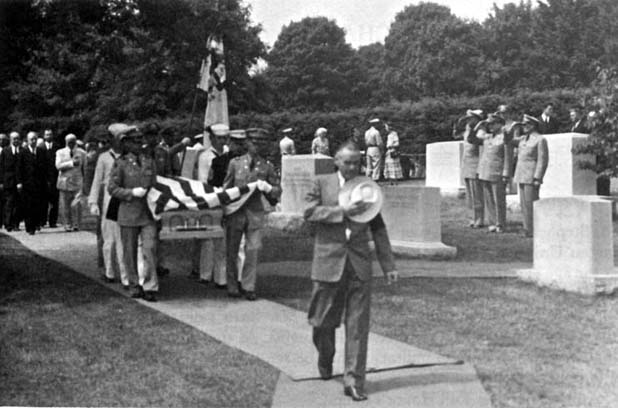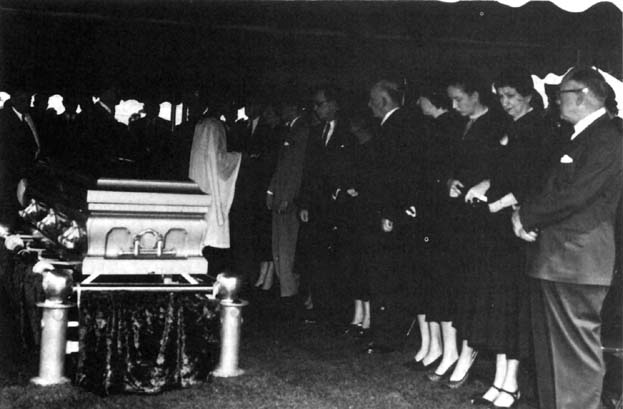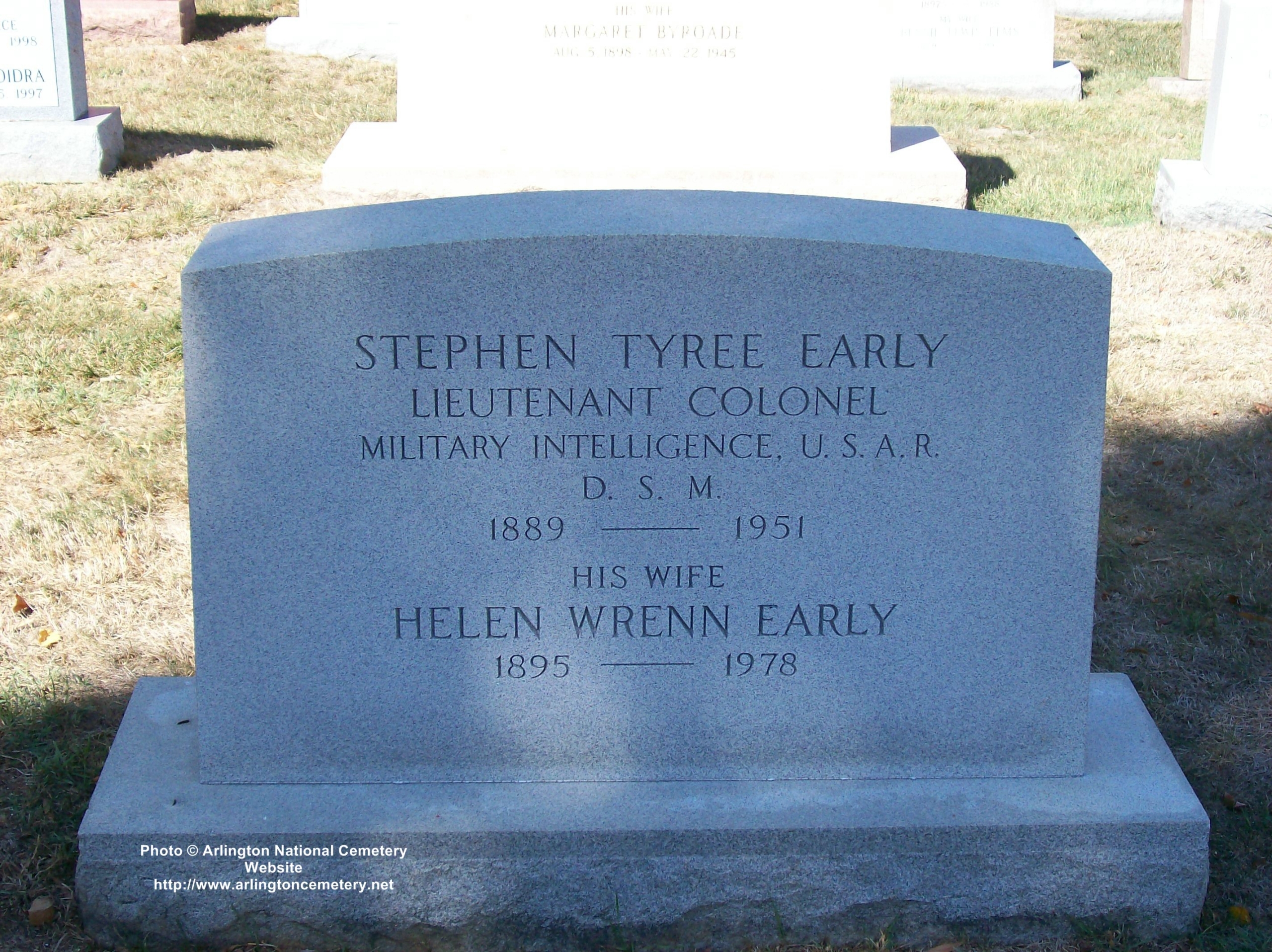Stephen Tyree Early (August 27, 1889 – August 11, 1951) met Franklin D. Roosevelt while covering the 1912 Democratic Convention as a reporter for the United Press.
From 1913 to 1917 Early was the Associated Press correspondent covering the Navy Department, during which time his acquaintance with Roosevelt and Louis Howe grew.
After serving in World War I with an Infantry Regiment and the STARS AND STRIPES he returned to the United States and was asked by Roosevelt to be the advance man for the 1920 Vice Presidential campaign.
After the election Early returned to the Associated Press, and in 1927 became the Washington representative of Paramount News.
After the election of 1932, Franklin Rooosevelt asked him to serve as one of the White House Secretaries, and be responsible for press relations.
Early held that post throughout the Roosevelt years, leaving government service June 1, 1945 to become Vice President of Pullman, Inc. He returned to the government as Under Secretary, later Deputy Secretary of Defense from April 1949 to June 1950. In December 1950 Early was briefly Press Secretary to President Truman, filling in after the sudden death of Charles G. Ross.
BURIAL IN ARLINGTON TOMORROW FOR EARLY
WASHINGTON, August 12, 1951 – A funeral service for Stephen T. Early, former White House Press Secretary and a former Deputy Defense Secretary will be held at 10 A.M. Tuesday in the Washington Cathedral. Burial will follow in Arlington National Cemetery.
Mr. Early, who suffered a heart attack last Tuesday, died yesterday in George Washington University Hospital at the age of 61.
Mr. early served in the First World War as a machine-gunner in France and for a time was on the staff of General of the Armies John J. Pershing.
Mrs. Early and the family requested friends not to send flowers and suggested that those wishing to pay tribute to Mr. Early make donations to the Washington Heart Foundation.
Cannon G. Gardner Monks will officiate at the cathedral service. At Arlington, the Rev. William Kepler, pastor of the Northminister Presbyterian Church in Washington will assist an Army chaplain not yet chosen.
President Truman yesterday paid glowing tribute to Mr. Early and his long-standing service to his country. Whether the Chief Executive will attend the funeral has not been announced.
TRUMAN ATTENDS FUNERAL OF EARLY
Mrs. Roosevelt Also Among 700 at Cathedral Service – Burial at Arlington
August 14, 1951 – Stephen T. Early, former Deputy Secretary of Defense and long-time press secretary to the late President Franklin D. Roosevelt, was buried in Arlington National Cemetery with full military honors today after a final tribute was paid by President Truman and leaders of government and the newspaper profession.
A gathering of 700 persons, including Mrs. Eleanor Roosevelt, widow of the President, attended the services in Washington Cathedral, and there was another large assemblage at the grave in Arlington.
Mr. Early died on Saturday of a heart ailment, having been stricken on the previous Monday while at his desk in the Washington officer of the Pullman Standard Car Company, of which he was a vice president.
The service at the Protestant Episcopal Cathedral was conducted by Canon G. Gardiner Monks, who in one of his prayers, praised Mr. Early for his “clear vision” and his patriotic and selfless devotion to his country. The Canon stood beside Mr. Early’s flag-draped coffin, immediately in front of Mr. Truman, as he read Tennyson’s “Crossing the Bar.”
President Truman was accompanied to the Cathedral by Fleet Admiral William D. Leahy, who served as Mr. Roosevelt’s Chief of Staff and who had a close association with Mr. Early. The government delegation included Chief Justice Fred Vinson, many members of the Cabinet and hundreds of Mr. Early’s friends.
Former Deputy Secretary of Defense Stephen T. Early
Combined Services Full Honor Funeral
11-14 August 1951
Stephen T. Early, former Deputy Secretary of Defense, died at George Washington University Hospital in Washington, D.C., on 11 August 1951. His death, at the age of sixty-one, followed a six-day illness caused by a heart ailment.
Robert A. Lovett, acting for George C. Marshall as Secretary of Defense, issued a formal memorandum announcing Mr. Early’s death to the Secretaries of the Army, Navy, and Air Force on 13 August. At that time, Mr. Lovett directed that “every appropriate military honor be rendered” to Mr. Early. Under plans and policies placed in effect in late 1949, the “appropriate military honor” was a Combined Services Full Honor Funeral.
Responsibility for arranging Mr. Early’s funeral rested with the Commanding General, Military District of Washington, Major General Thomas W. Herren. General Herren, working closely with the Early family, arranged for a funeral service at the Washington National Cathedral at 1000 on 14 August. Since Mr. Early had served in the Army in World War I, burial was to take place in Arlington National Cemetery. A motorized cortege was to take Mr. Early’s body from the cathedral to the Memorial Gate of Arlington National Cemetery, where, before the military escort formation, the casket was to be transferred to a caisson. The body was then to be escorted to the gravesite in Section 6, below the Memorial Amphitheater, for the final service.
After the former Deputy Secretary’s death on 11 August, the body was taken to Gawler’s funeral establishment where it remained until midmorning on the 14th, when it was taken by hearse to the Washington National Cathedral. Met by General Herren as escort commander, members of the clergy, the national color detail, the personal flag bearer, and a joint body bearer team of eight, the casket was taken in procession into the cathedral for the funeral service.
At 1000 Canon G. Gardiner Monks conducted the rites at the cathedral. Among those attending the service with the Early family was President Harry S. Truman. He was accompanied by Fleet Admiral William D. Leahy, who had been President Roosevelt’s chief of staff during World War II, and who had been closely associated with Mr. Early when the latter had served as President Roosevelt’s press secretary. Also in attendance were Mrs. Eleanor Roosevelt, government officials, and hundreds of Mr. Early’s friends. Present also were dignitaries whom the Early family had asked to serve as honorary pallbearers, among them Vice President Alben W. Barkley, Chief Justice Fred M. Vinson, Secretary of Defense George C. Marshall, Secretary of the Army Frank Pace, Jr., Secretary of the Air Force Thomas K. Finletter, Mr. Sam Rayburn, General of the Army Omar N. Bradley, and Mr. Bernard M. Baruch.
At the close of the funeral service, Mr. Early’s casket was taken in procession out of the cathedral and placed in a hearse. The motorized cortege then formed and proceeded to Arlington National Cemetery.
The military escort previously had formed on the lawn at the cemetery’s Memorial Gate, facing on line toward Memorial Drive over which the cortege would approach. On the left of the formation was the U.S. Army Band. To the band’s right, in order of seniority of service, were four ninety-man companies, one each from the Army, Marine Corps, Navy, and Air Force. Waiting on Memorial Drive directly in front of the escort troops was the caisson, and nearby stood the national color detail, personal flag bearer, and joint body bearer team.
When the cortege arrived, the hearse stopped beside the caisson. In a brief ceremony, the escort units saluted as Mr. Early’s casket was transferred from the hearse to the caisson. General Herren then led the way through the cemetery to the gravesite. Following the escort commander was the band, which played Chopin’s “Funeral March” as the procession moved. Next came the four troop companies. Behind them were the national color detail, an Army chaplain, the caisson flanked by the body bearers, the personal flag bearer, members of the Early family, and other mourners. As the funeral procession moved to the grave, the 3d Infantry battery, from a position in the cemetery, fired a 19-gun salute, spacing the rounds so that the last was fired as the procession reached the grave.
The graveside service was conducted by the Army chaplain, assisted by the Reverend William Kepler, pastor of Northminster Presbyterian Church. Following the benediction, a second 19-gun salute was fired, a rifle squad delivered the traditional three volleys, and an Army bugler sounded taps. At the conclusion of the rites, Canon Monks presented the flag that had draped the casket of the former Deputy Secretary of Defense to Mrs. Early.
Michael Robert Patterson was born in Arlington and is the son of a former officer of the US Army. So it was no wonder that sooner or later his interests drew him to American history and especially to American military history. Many of his articles can be found on renowned portals like the New York Times, Washingtonpost or Wikipedia.
Reviewed by: Michael Howard



